- Главная страница
- -Virtual museum
- -Audio tours
Audio tours
We present to your attention our Museum guides at the free audio tours service IZI.Travel. We offer:
- "Top Museum List: Rarities and Art-objects" which presents 50 memorabilia of our collection and information about the mansions, where our Museum is situated.
- Petrograd. 1917. One year of the history. Petrograd was the capital of the Russian Empire during the Revolution of 1917, after which the 300-year long monarchy collapsed, society was split in two, and civil war broke out. Take a trip around the city with us, and see the places where the most important events of 1917 took place. Our tour will finish in the State Museum of the Political History of Russia, where you can learn more about the Revolution.
- Around Troitskaya square. After visiting the Museum of Political History of Russia, spend more time on Petrogradskaya side. Consider taking a walk around the Troitskya Square and exploring the other sites of the area. The walk will eventually bring you to cruiser "Aurora" while every site along the way will introduce you to one of the pages of Russia’s political history.
- Constructivism: between utopia and reality. We invite you on a walking tour around Petrogradskaya Side area. Here, there are great examples of civil and industrial architecture, which will aid you in learning about different architectural styles; you’ll learn their basic features, find their similarities and differences, and notice the details. This area is especially charming for those who prefer all the styles of Art Nouveau and Neoclassicism. However, the authors of this tour, the staff of the Museum of Political History of Russia, have their own architectural preferences. They are interested in Constructivism, the architectural movement of the revolutionary avant-garde.
- The unofficial poetry of Petrograd/Leningrad: a literary guided tour. We are inviting you to a guided tour of memorable poetic places of our city that harbored the proud and free spirit of the unofficial and uncensored poetry of the twentieth century. We recommend you to end your tour in the Museum of Political History of Russia. Its exposition will help you to better understand and decipher many poetic images and metaphors, help you to trace how the language and the poetic forms changed with time, and see why the lives of many poets ended up the way they did. And then the figures of these poets and things that they created will come alive for us and will open up to the eyes of a contemporary person in all the historical complexity of their meaning.
















